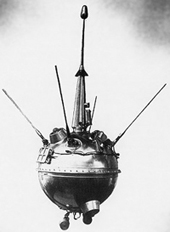
Luna 2 becomes the first artifact of humanity to strike the moon.
The Soviet Union launched the Sputnik-like probe from the Baikonur Cosmodrome on September 12. It took thirty-three and a half hours to reach its destination. Hitting the moon, a prestigious accomplishment for the Soviet space program, was not Luna 2’s only objective. Prior to impact, the craft sent back data confirming that the moon had neither a magnetic field nor any radiation belts.

Because Luna 2 itself lacked a propulsion system, it was guided along by the third stage of its SS-6 booster rocket until the two separated shortly before impact. The probe hit the lunar surface east of Mare Serenitatis, momentarily disrupting the serenity near the Sea of Serenity. The booster’s third stage hit the moon about half an hour later.
Luna 2 was the second in the Soviet Union’s ambitious and long-running Luna program, which collected information about the lunar environment at least in part to prepare for a Russian attempt to land a man on the moon, which never materialized. Lunas 2, 9, 13, and 15 all reached the moon before Neil Armstrong (see here), but the big prize eluded the Soviets. The program ended with Luna 24 in 1976.
Despite the Soviets’ failure to get a man to the moon, the Luna program must be considered a success in the long view. Among its achievements: first lunar flyby (Luna 1), first landing (Luna 2), first photographs from the far side of the moon (Luna 3), first successful soft landing on the lunar surface (Luna 13), first analysis of lunar soil, and first deployment of a lunar rover (Luna 17).—TL